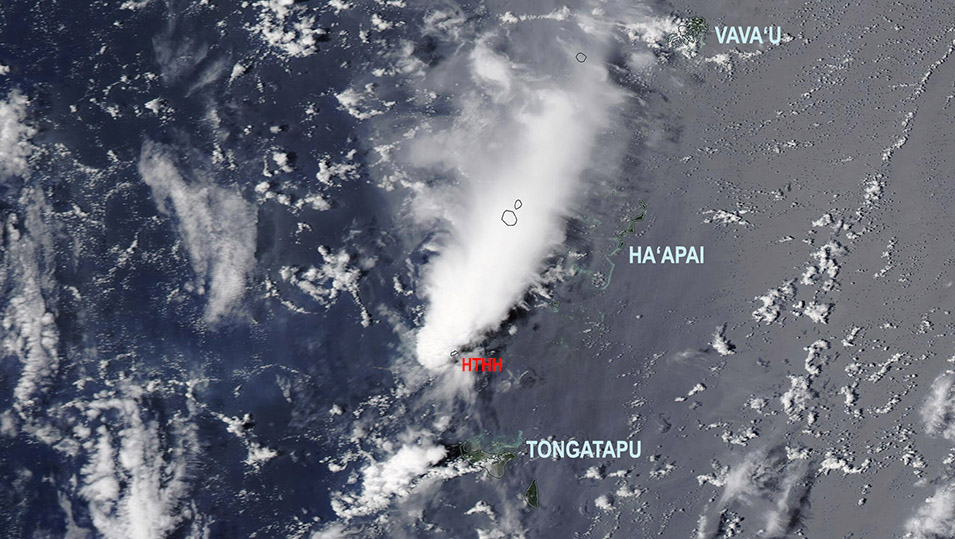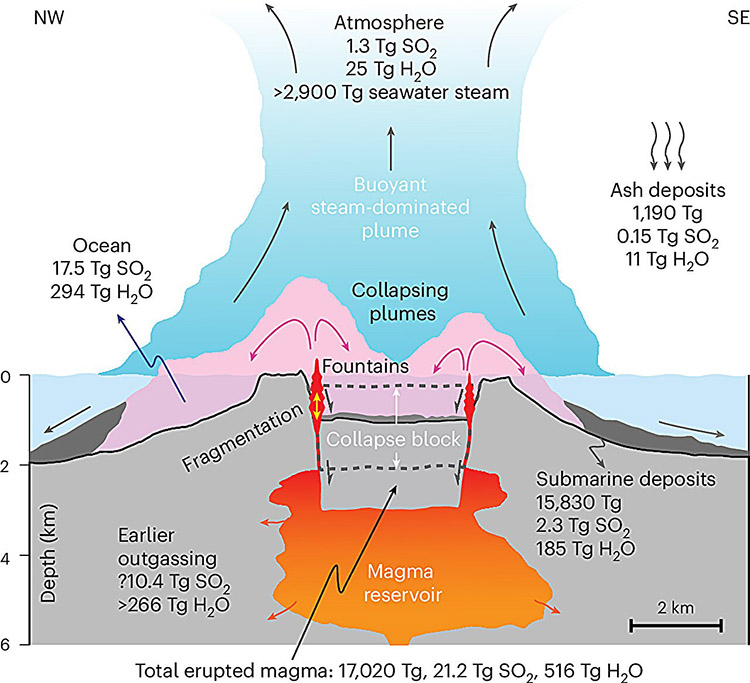
Researchers say that the Hunga-Tonga Hunga-Ha'apai (HTHH) volcanic eruption:
- was the largest eruption witnessed in the modern era;
- injected up to 3 billion tonnes of steam into the atmosphere in an hour;
- water vapour reached the stratosphere and the mesosphere (57 km);
- cooled the Southern Hemisphere;
- released up to 20 million tonnes of sulphur dioxide into the ocean.
Volcanoes erupting underwater have a distinctive effect on the climate that is larger and more widespread than previously thought, according to an international group led by University of Auckland and Tongan scientists.
Research on Tonga’s devastating 2022 Hunga (HTHH) eruption has just been published in the journal Nature Geoscience.
“Submarine volcanism has previously been overlooked in global climate studies, because there is typically not much atmospheric sulphur dioxide released,” says Professor Shane Cronin, a co-lead author of the study with postdoctoral fellow Dr Jie Wu.
However, while sulphur dioxide can lead to significant climate effects, so too can water vapour.
At its peak Hunga’s eruption injected up to 3 billion tonnes of steam into the atmosphere in a single hour, with the water vapour reaching the stratosphere and even the mesosphere more than 57 km up, Cronin says.
“The eruption has been shown by several recently published studies to have cooled the Southern Hemisphere and cause a range of other atmospheric and climate impacts that we are still discovering,” he adds.
20 million tonnes of sulphur diioxide
Hunga had the potential for a global impact from sulphur dioxide. The team estimates up to 20 million tonnes of it was released during the eruption, however, most of the sulphur went directly into seawater at depths between 300m and 1100m.
"The unusual feature of this huge volcano-climate impact from Hunga is that it was not caused by sulphur – like for other major events in the past (e.g., 1991 Pinatubo, Philippines, the second-highest eruption plume ever measured).
"The Hunga eruption was under the sea throughout the entire 11 hour event. This meant that hot magma interacted with seawater and almost all of the 20 million tonnes of sulphur released by the eruption went into the ocean.
"The submarine explosions may have shielded us from the effects of sulphur dioxide in the atmosphere, but it had an unforeseen impact of turning huge amounts of sea-water into steam (up to a few billion tonnes). This steam rapidly rose above the volcano and drove the eruption plume to its record heights. The wet-plume hydrated the upper atmosphere, causing a range of climatic impacts that are still being studied world wide."

Cronin, is Professor of Volcanology at the School of Environment at Waipapa Taumata Rau, University of Auckland, while Wu is now based at the University of Otago.
University of Auckland and staff and students have been working with Tongan partners to understand the wider implications of submarine volcanism in the Southwestern Pacific in the aftermath of Hunga, the largest eruption witnessed in the modern era. Tongan scientists Folauhola Latu’ila and Taaniela Kula of Tonga Geological Services also worked on the research.
“We are striving to understand the broader hazards of submarine volcanism including tsunami and damage to shorelines and internet data cables as well as how these eruptions affect our environment and climate,” says Cronin.
The work is supported by an MBIE Endeavor Research Programme grant from 2024.
The research Paper was published in Nature Geoscience, with the following credits:
Organisations - University of Auckland, University of Otago, Queensland University of Technology (QUT), University of Canterbury, Australian Synchrotron, Korean Polar Research Institute, INGV (Italy), Leibniz Universität Hannover (Germany), Universidad Complutense de Madrid (Spain), Columbia University (USA), New Mexico State University (USA), Tonga Geological Services.
This research is financially supported by New Zealand Government Ministry of Business (Innovation and Employment Endeavour Research Program UOA24103), Royal Society of New Zealand Te Apārangi (Marsden project MFP-UOO2218), Australian Nuclear Science and Technology Organisation (ANSTO), Australian Synchrotron and the New Zealand Synchrotron Group (project M18638), the Korean Polar Research Institute (project PE22550) and the Alexander von Humboldt Foundation (for D.G.-G.).



